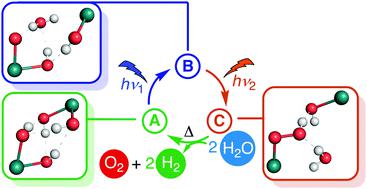当前位置:
X-MOL 学术
›
Energy Environ. Sci.
›
论文详情
Our official English website, www.x-mol.net, welcomes your
feedback! (Note: you will need to create a separate account there.)
Two-photon, visible light water splitting at a molecular ruthenium complex
Energy & Environmental Science ( IF 32.4 ) Pub Date : 2021-6-18 , DOI: 10.1039/d1ee01053k Jacob Schneidewind 1, 2, 3 , Miguel A. Argüello Cordero 3, 4, 5, 6 , Henrik Junge 1, 2, 3 , Stefan Lochbrunner 3, 4, 5, 6 , Matthias Beller 1, 2, 3
Energy & Environmental Science ( IF 32.4 ) Pub Date : 2021-6-18 , DOI: 10.1039/d1ee01053k Jacob Schneidewind 1, 2, 3 , Miguel A. Argüello Cordero 3, 4, 5, 6 , Henrik Junge 1, 2, 3 , Stefan Lochbrunner 3, 4, 5, 6 , Matthias Beller 1, 2, 3
Affiliation

|
Water splitting to give molecular oxygen and hydrogen or the corresponding protons and electrons is a fundamental four-electron redox process, which forms the basis of photosynthesis and is a promising approach to convert solar into chemical energy. Artificial water splitting systems have struggled with orchestrating the kinetically complex absorption of four photons as well as the difficult utilization of visible light. Based on a detailed kinetic, spectroscopic and computational study of Milstein's ruthenium complex, we report a new mechanistic paradigm for water splitting, which requires only two photons and offers a new method to extend the range of usable wavelengths far into the visible region. We show that two-photon water splitting is enabled by absorption of the first, shorter wavelength photon, which produces an intermediate capable of absorbing the second, longer wavelength photon (up to 630 nm). The second absorption then causes O–O bond formation and liberation of O2. Theoretical modelling shows that two-photon water splitting can be used to achieve a maximum solar-to-hydrogen efficiency of 18.8%, which could be increased further to 28.6% through photochemical instead of thermal H2 release. It is therefore possible to exceed the maximum efficiency of dual absorber systems while only requiring a single catalyst. Due to the lower kinetic complexity, intrinsic utilization of a wide wavelength range and high-performance potential, we believe that this mechanism will inspire the development of a new class of water splitting systems that go beyond the reaction blueprint of photosynthesis.
中文翻译:

双光子可见光在分子钌配合物中分解水
水分解产生分子氧和氢或相应的质子和电子是基本的四电子氧化还原过程,它构成了光合作用的基础,是将太阳能转化为化学能的一种很有前途的方法。人工水分解系统一直在努力协调四个光子的动力学复杂吸收以及可见光的难以利用。基于对 Milstein 钌配合物的详细动力学、光谱学和计算研究,我们报告了一种新的水分解机制范式,它只需要两个光子,并提供了一种将可用波长范围扩展到可见光区域的新方法。我们表明,双光子水分解是通过吸收第一个较短波长的光子来实现的,它产生一种能够吸收第二个更长波长光子(高达 630 nm)的中间体。第二次吸收导致 O-O 键的形成和 O 的释放2 . 理论模型表明,双光子水分解可用于实现 18.8% 的最大太阳能到氢效率,通过光化学而不是热释放H 2可以进一步提高到 28.6%。因此有可能超过双吸收器系统的最大效率,而只需要一种催化剂。由于较低的动力学复杂性、宽波长范围的内在利用和高性能潜力,我们相信这种机制将激发一类超越光合作用反应蓝图的新型水分解系统的开发。
更新日期:2021-06-18
中文翻译:

双光子可见光在分子钌配合物中分解水
水分解产生分子氧和氢或相应的质子和电子是基本的四电子氧化还原过程,它构成了光合作用的基础,是将太阳能转化为化学能的一种很有前途的方法。人工水分解系统一直在努力协调四个光子的动力学复杂吸收以及可见光的难以利用。基于对 Milstein 钌配合物的详细动力学、光谱学和计算研究,我们报告了一种新的水分解机制范式,它只需要两个光子,并提供了一种将可用波长范围扩展到可见光区域的新方法。我们表明,双光子水分解是通过吸收第一个较短波长的光子来实现的,它产生一种能够吸收第二个更长波长光子(高达 630 nm)的中间体。第二次吸收导致 O-O 键的形成和 O 的释放2 . 理论模型表明,双光子水分解可用于实现 18.8% 的最大太阳能到氢效率,通过光化学而不是热释放H 2可以进一步提高到 28.6%。因此有可能超过双吸收器系统的最大效率,而只需要一种催化剂。由于较低的动力学复杂性、宽波长范围的内在利用和高性能潜力,我们相信这种机制将激发一类超越光合作用反应蓝图的新型水分解系统的开发。











































 京公网安备 11010802027423号
京公网安备 11010802027423号